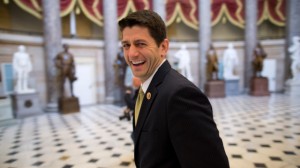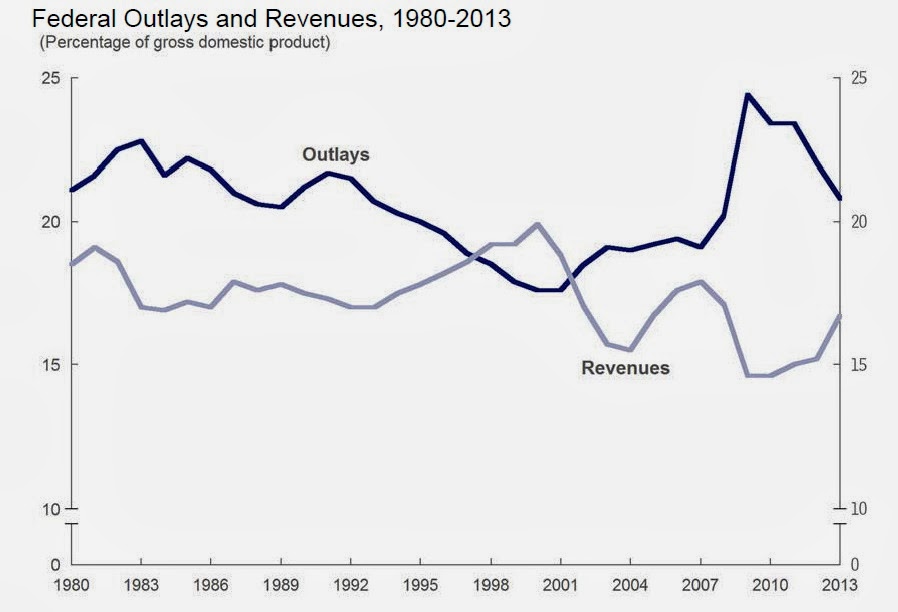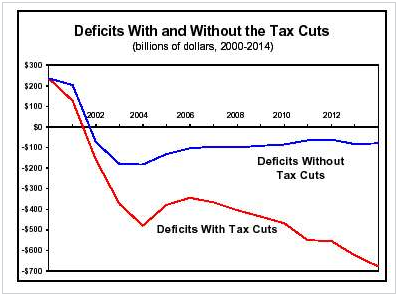
House Budget Committee Chairman Rep. Paul Ryan (R-WI) laughs as he walks to his office on Capitol Hill in Washington, Friday, Oct. 11, 2013. (AP Photo/ Evan Vucci)
Republicans are signaling that when they take control of the Senate in January, they’ll try to change the way a key government watchdog does math. If they get their way, it will effectively put a thumb on the scale of all future legislation.
The Congressional Budget Office (CBO) informs virtually all of our political debates. Made up of non-partisan career technocrats, the CBO’s most important function is to “score” proposed legislation, projecting how a bill would impact future budgets if it were passed. When the CBO concludes that a piece of legislation will increase future deficits, it provides a powerful argument against the measure. When they project that a proposal will shrink the government’s debt, it allows proponents to claim that it’s the “fiscally responsible” thing to do. Key findings from the CBO’s reports are eagerly consumed and broadly disseminated by politicians, pundits and political reporters.
A number of Republicans have called for the CBO to incorporate what US News & World Report calls a “gimmick” that would result in tax cuts magically paying for themselves in future CBO scores. In fact, it would likely result in the CBO claiming that even deep tax cuts for corporations and the wealthy would result in more revenues coming into the government’s coffers. We could have our cake and eat it, too!
The gimmick is called “dynamic scoring,” and is based on economic models that purport to show that tax cuts unleash so much new economic activity that ultimately, they result in more taxes being collected.
Budget guru Stan Collender, executive vice president of Qorvis Communications, tells Moyers & Company that to a degree both the CBO and Congress’s Joint Committee on Taxation already use dynamic scoring. Economists agree that changes in taxation influence how much money individuals and corporations spend. “They just don’t use it to the extent that tax cut proponents want,” says Collender. “And there’s very little substantive evidence to justify the kind of dynamic scoring that they want.”
“Make no mistake,” Collender adds. “This is not an attempt to fix the substance, this is an attempt to fix the politics to make it easier to cut taxes.”
In an interview with Politico, Rep. Paul Ryan (R-Wisconsin) claimed, falsely, that “Our rules in Congress require that we don’t take into consideration behavioral changes or economic effects as a result of tax reform.” He told a business group, “What we want to do is change our measurement so that we can use — people say it’s dynamic scoring. I really prefer to call it reality-based scoring.”
Asked about that characterization, Stan Collender says, “Almost all reputable economists – and past CBO directors from both parties – have rejected the kind of dynamic scoring that Paul Ryan wants out-of-hand. They’ve looked at it, they’ve written about it and they’ve found nothing to support it. What you’ve got to understand is that proponents of this kind of dynamic scoring simply take it on faith.”
Fortunately, we have a recent real world experiment with which to evaluate Ryan’s claim to “reality” — the effect of two rounds of deep tax cuts passed by the Bush administration in 2001 and 2003 (and renewed in 2010).
Time magazine’s Justin Fox went back and reviewed what Republicans had said in the past about these (and other) cuts. He concluded, “If there’s one thing that Republican politicians agree on, it’s that slashing taxes brings the government more money.”
“You cut taxes, and the tax revenues increase,” President Bush said in a [2006] speech. Keeping taxes low, Vice President Dick Cheney explained in a [2007] interview, “does produce more revenue for the Federal Government.” [During the 2008 campaign] John McCain declared… that “tax cuts . . . as we all know, increase revenues.” His rival Rudy Giuliani couldn’t agree more. “I know that reducing taxes produces more revenues,” he… [said in a] TV ad.
All of these statements – and there are many, many more like them on the record – were based on the kind of dynamic scoring models that Republicans are likely to push the CBO to adopt.
So how did reality “score” these claims?
Tax collections fell off a cliff after the 2001 and 2003 Bush tax cuts. By 2009, the cuts, combined with the effects of the economic downturn, left federal tax revenues as a share of our overall economic output at their lowest point since 1950. They remained that way through 2012. This graphic from the CBO tells the tale:
And what about the “fiscal responsibility” of those cuts — or lack thereof? In 2001, George W. Bush inherited a budget surplus from the Clinton administration; by the time he left office, he’d turned it into a massive deficit. This graphic, from the Center on Budget and Policy Priorities, shows that while Bush’s unpaid wars and the recession played a roll in pushing the federal budget into the red, the tax cuts were far and away the leading cause of the turnaround.
Keep these figures in mind the next time you hear Paul Ryan or one of his allies talking about “reality-based scoring.” It’s voodoo economics at its finest.

This work is licensed under a Creative Commons Attribution-NoDerivatives 4.0 International License.





